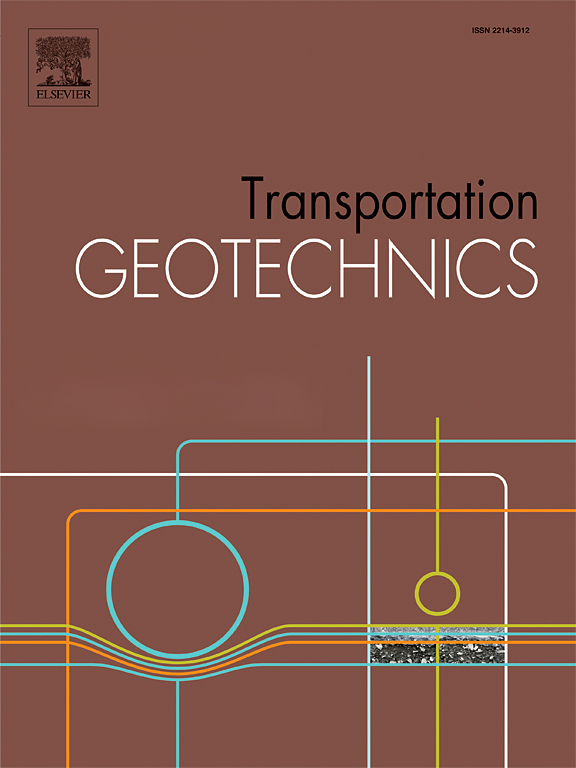The influence of sand content on dynamic behaviors of ballast bed from a multiscale perspective
IF 4.9
2区 工程技术
Q1 ENGINEERING, CIVIL
引用次数: 0
Abstract
In desert regions, sand intrusion into the ballast bed is unavoidable, leading to a reduction in the elasticity of the ballast bed and posing potential risks to the service safety. Previous studies have focused on the behaviors of sandy ballast beds in 2D planes using discrete element method (DEM), where sand content is typically calculated utilizing sand areas within the ballast voids, different from that using sand volumes or mass in 3D space. Therefore, the impacts of sand content on the multiscale responses of the ballast bed are not fully addressed. In this paper, 3D full-scale half-sleeper models with various sand contents are established via DEM. Multiscale responses of sandy ballast bed obtained by laboratory tests are utilized to verify the reliability of established models. Simulation results show that macroscopically, sand intrusion increases the stiffness and consequently reduces the elasticity of the ballast bed. Microscopically, sand contaminant restricts the translational acceleration of ballast particles, while simultaneously intensifying the angular acceleration. In terms of particle contact, the anisotropy of the directional distribution of contact force among ballast particles is weakened by sand contaminant. Therefore, the inter-particle contact force among ballast particles becomes more uniform, particularly beneath the rail. A normalized parameter is proposed to quantify the filling effect of sand contaminant, based on which the relationships between multiscale dynamic responses and sand content are linearized. The linearization results indicate that the sand intrusion has more significant impacts on the multiscale responses of the ballast bed under higher loading magnitude.
从多尺度角度看含沙量对压载床动态行为的影响
在沙漠地区,沙粒侵入道碴床是不可避免的,这会导致道碴床弹性降低,并对服务安全构成潜在风险。以往的研究侧重于使用离散元素法(DEM)在二维平面上研究含沙道碴床的行为,其中含沙量通常是通过道碴空隙中的沙子面积计算得出的,与三维空间中使用沙子体积或质量计算得出的结果不同。因此,含沙量对道碴床多尺度响应的影响尚未得到充分解决。本文通过 DEM 建立了不同含沙量的三维全尺寸半卧铺模型。利用实验室试验获得的砂质道碴床多尺度响应来验证所建模型的可靠性。模拟结果表明,从宏观上看,沙子的侵入会增加刚度,从而降低道碴床的弹性。从微观上看,沙粒污染物限制了压载颗粒的平移加速度,同时也增大了角加速度。在颗粒接触方面,压载颗粒间接触力方向分布的各向异性因砂污染物而减弱。因此,道碴颗粒间的接触力变得更加均匀,尤其是在轨道下方。我们提出了一个归一化参数来量化砂污染的填充效应,并在此基础上对多尺度动态响应与含沙量之间的关系进行了线性化处理。线性化结果表明,在较高的荷载量级下,砂的侵入对道碴床的多尺度响应有更显著的影响。
本文章由计算机程序翻译,如有差异,请以英文原文为准。
求助全文
约1分钟内获得全文
求助全文
来源期刊

Transportation Geotechnics
Social Sciences-Transportation
CiteScore
8.10
自引率
11.30%
发文量
194
审稿时长
51 days
期刊介绍:
Transportation Geotechnics is a journal dedicated to publishing high-quality, theoretical, and applied papers that cover all facets of geotechnics for transportation infrastructure such as roads, highways, railways, underground railways, airfields, and waterways. The journal places a special emphasis on case studies that present original work relevant to the sustainable construction of transportation infrastructure. The scope of topics it addresses includes the geotechnical properties of geomaterials for sustainable and rational design and construction, the behavior of compacted and stabilized geomaterials, the use of geosynthetics and reinforcement in constructed layers and interlayers, ground improvement and slope stability for transportation infrastructures, compaction technology and management, maintenance technology, the impact of climate, embankments for highways and high-speed trains, transition zones, dredging, underwater geotechnics for infrastructure purposes, and the modeling of multi-layered structures and supporting ground under dynamic and repeated loads.
 求助内容:
求助内容: 应助结果提醒方式:
应助结果提醒方式:


